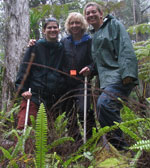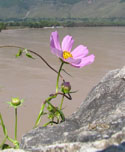 |
|||||
| Biology Home Page | News | Calendar | Make a Gift | |||||
|
Fall 2008 | Return to issue home
Putting a Price Tag on Nature By Kristy Brady
In the call to protect pristine environments, conserving biological diversity is often the prominent reason broadcasted. But there is another reason, which is arguably more important, though not routinely recognized by society. That is the broad array of ecosystem services performed, those services the environment conducts free of charge, such as carbon sequestration, flood control, and even recreation and tourism. Ecosystem services often provide a more meaningful reason to protect a region than simply preserving biodiversity, especially in areas suffering extreme poverty. However, to date it has been difficult to assign a monetary value to ecosystem services, but it is necessary if a cost/benefit analysis is to be made. The Natural Capital Project is working to make the process of calculating the value of ecosystem services much easier. The Natural Capital Project is a collaborative venture between The Nature Conservancy, World Wildlife Fund and the Woods Institute for the Environment at Stanford University. UW Zoology alum Heather Tallis, Ph.D., '06, is the lead scientist for the Natural Capital Project. She says the overarching goal of the project is to “bring more information about the true value of nature to people affecting decisions,” including those in government, the World Bank, corporations, conservation organizations and affectted communities. One way the project is moving toward its goal is by developing a tool that can standardize the practice of assigning value to ecosystem services. This tool is called the Integrated Valuation of Ecosystem Services and Tradeoffs tool, or InVEST for short. InVEST is a free computer program that enables users to quantify the value of an ecosystem service and how that value might change given different possible landscape management plans. InVEST also allows users to predict how different projects will affect society in the context of the ecosystem service provided. For example, if a watershed is being considered for timber harvest, a value can be assigned to the ecosystem services provided by the watershed (e.g., water purification, erosion control), as well as to the timber that would be extracted. Thus, a more meaningful cost/benefit analysis can be conducted when making the decision to log or not.
As the lead scientist for the Project, Heather was responsible for coordinating InVEST’s development, which took about a year and a half. Currently, trials using InVEST are running in eight locations: the Upper Yangtze River Basin in China, the Eastern Arc Mountains in Tanzania, the Sierra Nevada Mountains in California, the Hawaiian Islands, the Willamette Basin in Oregon, the entire Amazon Basin, Ecuador and Colombia. These sites were chosen because each has a high level of biodiversity and provides significant ecosystem services for large populations of people, but faces the threat of degradation or conversion. Moreover, present in each of these sites is the opportunity to adopt policies that value ecosystem services. InVEST was scheduled to be released in October for public use. The project hopes to begin trial runs for use in the private sector soon, as well. There has been considerable interest from the private sector, including Nissan, Goldman Sachs, and BC Hydro (a large hydropower corporation), which Heather says is “incredibly inspiring” because such corporations have a large impact on the environment and society. Currently, InVEST is designed to evaluate terrestrial and freshwater ecosystems only. However, Heather says there are plans to add the capability to evaluate marine systems in the near future. In addition, the project hopes to expand InVEST to have the capacity to inform poverty-related issues. Many areas at risk for environmental degradation or destruction, and thus a collapse of ecosystem services, are in regions of extreme poverty; alleviating poverty is necessary if longterm, sustainable preservation of these areas and the services they provide is the goal. With the debut of InVEST, the Natural Capital Project has taken a much-needed first step toward making ecosystem services tangible commodities. To learn more about the Natural Capital Project and to read about its demonstration projects, visit http://www.naturalcapitalproject.org.
Fall 2008 | Return to issue home | |||||
|
|||||



